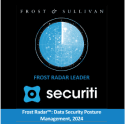Biometric data is a type of data that is related to the unique physical characteristics of individuals, such as fingerprints, facial features, or voice patterns, used for identification, authentication, and access control purposes.
Applications of Biometric Data
Here are the most common biometric data uses:
Enhanced Security Measures
In the physical realm, biometric systems provide a reliable way to manage access to both public and private premises, and much more. In the digital realm, biometric authentication protects sensitive data on devices and internet sites against unauthorized access and provides a plethora of security measures organizations can utilize to ensure data security.
Streamlining Identification Processes
Biometrics streamlines identification processes. For instance, for quicker immigration and boarding procedures, airports can utilize face recognition technology. Likewise, police enforcement organizations use biometric information to quickly and accurately identify individuals.
Healthcare Industry
Biometrics is essential to patient identification in healthcare as it ensures that medical data is correctly matched to the right patient and securely stored, minimizing medical mistakes and errors and improving patient care.
Banking and Financial Services
The banking industry widely leverages biometric data to ensure safe transactions. Biometrics significantly enhances the customer experience and provides an additional degree of protection to a variety of applications, such as speech recognition in customer service and fingerprint scanning for payment authorization.
Consumer Electronics and Personalization
With smartphones and tablets utilizing fingerprint and face recognition technologies for user verification, biometric technology has become a standard in consumer electronics. This provides a smooth user experience in addition to device security.
What are Biometric Authentication Technologies?
Biometric authentication technologies provide a more secure alternative to standard passwords and PINs by using distinctive biological traits to validate individual identities.
Among these technologies is fingerprint scanning, which is by far the most popular because of its simplicity of use and compatibility with most devices. Another rapidly developing method is facial recognition technology, which is embedded within mobile devices and security systems. It analyzes face characteristics using sophisticated algorithms to authenticate and authorize.
Iris scanning, renowned for its exceptional precision, examines the distinct patterns seen on the iris and is used in high-security settings. Voice recognition is another technology that is widely embedded within most modern-day devices – typically home assistants. It leverages an individual’s unique voice pattern for authentication and feedback.
New technologies that are gaining traction in high-security and specialized fields, such as vein pattern identification and gait analysis, are broadening the scope of biometric authentication. While these technologies improve security and user ease overall, they also bring up significant privacy and ethical concerns.
Privacy and Security Concerns in Biometric Data Handling
Since biometric data handling involves managing sensitive data—like fingerprints, face recognition, and iris scans—it introduces serious privacy and security risks. The key concern is the possibility of unauthorized access and data exploitation, which might result in identity theft, processing without obtaining the individual’s consent, or a breach, which may result in irrevocable privacy violations.
Furthermore, in the absence of strict restrictions, governments or commercial groups may abuse biometrics, potentially resulting in privacy violations. As biometric data is irreversible, it requires robust encryption, rigorous access control, and comprehensive legal frameworks to prevent exploitation and ensure that an individual’s privacy rights are respected.
Legal and Regulatory Considerations for Biometric Data
Governments and regulatory agencies are constantly introducing frameworks and guidelines to strike a balance between technology improvements, privacy rights, and ethical concerns, resulting in a complex and dynamic legal and regulatory framework for biometric data.
Consent is a crucial legal component, requiring individuals to be fully informed about the collection, use, and storage of their biometric data. Strict guidelines are imposed on biometric data processing by data protection regulations, such as the European Union’s General Data Protection Regulation (GDPR), which emphasizes the necessity for robust security measures and restricts the use of data for certain lawful purposes.
Additionally, organizations handling biometric data are subject to regulations requiring them to demonstrate compliance with evolving privacy standards and to be transparent and accountable in their data collection and processing purposes. The right to privacy and the prohibition against discrimination also ensure that biometric technologies respect an individual’s rights and don't provide biased results.
It's no secret that the rapid development and deployment of biometric technology pose a challenge to the legal system, requiring constant amendments and the enactment of new laws to adequately safeguard individual rights.
Best Practices for Biometric Data Protection
To safeguard sensitive personal data and ensure privacy, it is essential to follow best practices for biometric data protection.
First and foremost, to safeguard biometric data against breaches and unauthorized access, the data must be stored using robust encryption. Strict access restrictions should be implemented so that only authorized individuals can handle biometric data.
To keep up industry’s security standards and detect vulnerabilities, regular security audits and compliance checks are essential. Enhancing overall protection involves educating users about biometric data security, including safe handling and privacy issues.
Clearly defined procedures for data deletion and retention are also crucial to ensure that biometric data is safely disposed of after being retained for the bare minimum of time. It is essential for organizations to comply with relevant legal and regulatory frameworks and remain abreast of evolving legal provisions to ensure continuous compliance.
Lastly, in the case of a data breach, having a robust incident response strategy is essential for prompt action and possible damage reduction.










